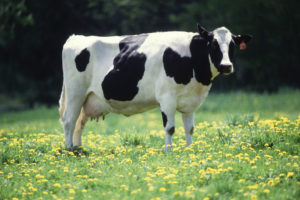“I’m attracted to fields that are impossible,” said Ken Jaffe. “I bought some cows, and one thing led to another.” Jaffe is a grass-fed beef farmer, and with his wife Linda he owns and runs Slope Farms in Meridale, New York, about 90 miles west of Albany. On hilly pastures with rocky soil unsuitable for anything but grass, Jaffe’s 200 cattle graze serenely all year long, even in the winter if there isn’t much frost. But like all small-scale beef farmers in the Northeast, Jaffe contends with a chicken-and-egg problem: he can’t process his beef economically enough to buy more cows, and the processors who transform his cows into steaks can’t reduce their prices until they have more volume to work with.
Jaffe was a full-time general practice physician in Park Slope, Brooklyn, when he bought his first cow in upstate New York 15 years ago. “I was interested in how we raise livestock, and human health,” he said. He wanted to know if he could raise cows for beef production in a way that was environmentally and medically sound but also economically tenable.
Americans are eating more red meat than ever, and farmers are raising more cows to meet that demand. The USDA estimates that in 2018 the average American will eat 222.2 pounds of red meat and poultry, up from 216.9 pounds in 2017 and just 201.8 in 2014. But the vast majority of this beef will not come from cows like Jaffe’s. According to the National Cattleman’s Beef Association, 81 percent of cattle being fattened for slaughter in 2016 were fed on feedlots with capacities of 1,000 or more. These are the industrial operations that enable American companies to produce beef so efficiently that McDonald’s can still sell a cheeseburger on its $1 menu.
Feedlots are linked to adverse effects on both the environment and human health, according to numerous studies. The sheer volume of waste cows produce, which would ordinarily fertilize the grass they graze on, instead accumulates, sending noxious particles into the air and threatening water supplies. And because cows consume an overwhelming amount of the antibiotic supply (the FDA puts the number around 70 percent) to ward off infection, common bacteria that also cause sickness in humans are given ample opportunity to develop resistance. There may come a day when some new strain emerges, and there is nothing in the antimicrobial arsenal left to defeat it.
“That day is now,” said Jaffe, who is also a medical doctor. “And it’s getting worse.” He cited recent cases of nafcillin-resistant staphylococcus and resistant strains of salmonella found in feedlot cows. According to the CDC, 23,000 people die every year from antibiotic resistant illness or infection, and that number is growing.
Jaffe is hardly the only one providing a model for healthy, sustainable farming. Mike Baker, the senior extension associate at Cornell University’s School of Agriculture, has made it his life’s work to help small-scale farmers in the Northeast raise cows efficiently and economically, the way he has for the past three decades. Baker finishes his cows on grain, which results in heated debates with Ken Jaffe, but maintains that the problem isn’t in the grass vs. grain dichotomy.
“We need to stop fighting each other,” he said. “It’s the whole system, not just grains.” And the real bottleneck of this system, and the reason grass-fed beef costs an average of $2 more per pound, lies in how cows are turned into beef. Large-scale processors, like Cargill Meat Solutions, can turn 1,500 cows a day into rib eyes and T-bones; the sheer volume keeps the cost per cow very low. The local processor Jaffe works with, Steiner Packing Company, handles just six or seven cows a day. Nathanial Brandon, who owns Steiner, said his 250 customers pay an average of $500 for every processed cow, but that price depends on the packaging. Jaffe, whose beef must travel to New York City, pays $700. If he had enough cows to work with a place like Cargill, Jaffe said, that $200 difference is all he would pay.
Steiner has been processing meat since 1952, and when it was first sold in 1976, there were nine slaughterhouses in the area. Now there are only three. “It’s a dying art,” said Brandon, who said he’s keeping afloat on the rising tide of the transparency trend in food. “It’s just been happening in the past 5-7 years,” he said. “People want to know where their meat comes from.” But that doesn’t help him process cows any faster or improve the labor market. “I’ve had an ad for a meat wrapper for four months now,” Brandon said. “This work isn’t for everyone.”
Jaffe believes that the only solution to this impasse is government intervention. He suggests leveraging the enormous purchasing power of the New York City school system, the second-largest American food procurer after the Defense Department, in order to fund a massive expansion of grass-fed beef production in New York and to offer children healthier versions of the foods they already eat.
“The government has to put its money where its mouth is,” Jaffe said, if they want to solve the problem of bacterial proliferation. He said that farmers in other industries have long benefited from the kind of legislation he advocates for, and cited laws requiring New York subsidized breweries and distilleries to buy produce from local farmers. During the craft spirits renaissance, this synergy resulted in a boom not just for imbibers in New York City but for hop, grain and rye farmers too.
“All the state government has to do,” Jaffe said, “is put healthy food for kids at the same level as beer.”


Your Comments